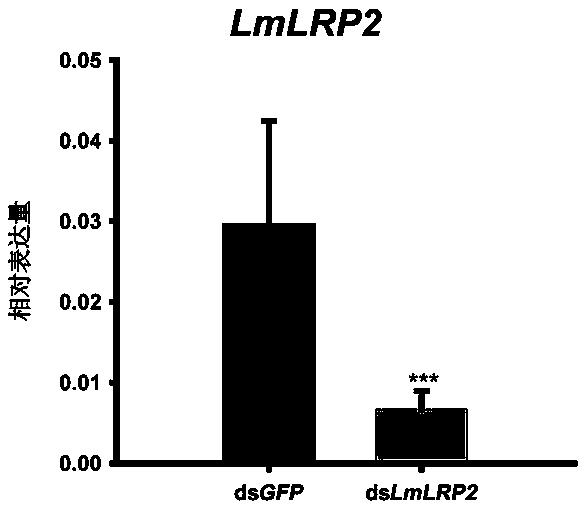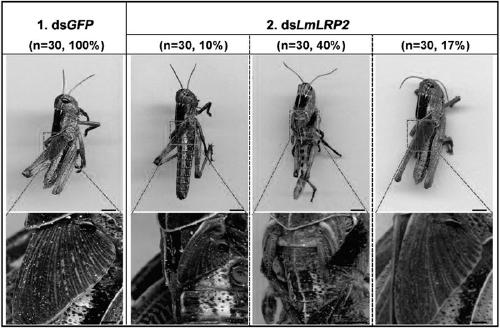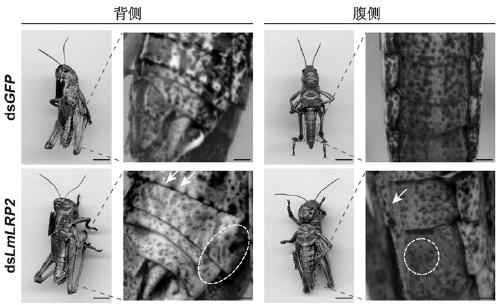Low-density lipoprotein receptor related gene 2 LmLRP2 of migratory locust and application of dsRNA of gene in prevention and control of migratory locust
A low-density lipoprotein and receptor technology, applied in DNA/RNA fragments, receptors/cell surface antigens/cell surface determinants, applications, etc., can solve environmental pollution, endanger human health, pesticide residues, etc.
- Summary
- Abstract
- Description
- Claims
- Application Information
AI Technical Summary
Problems solved by technology
Method used
Image
Examples
Embodiment 1
[0017] Example 1: Obtaining the sequence of migratory locust low-density lipoprotein receptor-related gene 2 and its dsRNA
[0018] 1. Sequence acquisition of low-density lipoprotein receptor-related gene 2 in migratory locusts
[0019] Based on the migratory locust transcriptome database, the sequence of the migratory locust low-density lipoprotein receptor-related gene 2 was searched using bioinformatics methods, and the migratory locust low-density lipoprotein receptor-related gene 2 ( LmLRP2 ) part of the sequence. Use the NCBI website to perform Blast analysis on the sequence, and at the same time combine the genome sequence of migratory locust to obtain its coding sequence, use BioEdit software to splice and compare, and obtain LmLRP2 Full length open reading frame sequence. The upstream and downstream primers were designed using primer premier5.0 software and sent to Shanghai Sangon Bioengineering Co., Ltd. for synthesis.
[0020] Extract the total RNA of the 5th ins...
Embodiment 2
[0026] Embodiment 2: Migratory locust low-density lipoprotein receptor-related gene 2 dsRNA kills 4-year-old migratory locust
[0027] 1. Injection of low-density lipoprotein receptor-related gene 2-specific dsRNA in migratory locusts
[0028] 4 µl (10 µg) dsRNA of SEQ ID NO: 1 (ds LRP2 ) with a 25 μl micro-syringe to inject between the second and third abdominal segments of the 4th instar nymphs on the first day. A total of 30 nymphs were injected, half male and half male. Inject the same volume and concentration of ds GFP into the control group. After injection, migratory locusts were raised in a 30°C constant temperature biochemical incubator (light:dark time = 14 h: 10 h, temperature 30±2°C, humidity 40±5%), and fed fresh wheat seedlings and wheat bran every day.
[0029] 2. Detection of silencing efficiency of migratory locust low-density lipoprotein receptor-related gene 2
[0030] 24 h after dsRNA injection, the epidermis of nymphs was extracted for RNA extraction...
Embodiment 3
[0033] Example 3: Migratory locust low-density lipoprotein receptor-related gene 2 dsRNA affects the permeability of migratory locust epidermis
[0034] After 4th instar nymphs were injected with dsRNA, the molted nymphs were transferred to a 2 ml centrifuge tube containing 1.5 ml dye solution (0.5% eosin (W / V, Sigma, a red water-soluble dye with a molecular mass of 691.86 Da)), After 30 minutes at 45°C, wash with water three times. The results showed that injection of ds GFP The migratory locusts cannot be colored while injecting ds LmLRP2 The epidermis of migratory locusts showed obvious coloring ( image 3 ), indicating that the permeability of the epidermis has changed.
PUM
 Login to View More
Login to View More Abstract
Description
Claims
Application Information
 Login to View More
Login to View More - R&D
- Intellectual Property
- Life Sciences
- Materials
- Tech Scout
- Unparalleled Data Quality
- Higher Quality Content
- 60% Fewer Hallucinations
Browse by: Latest US Patents, China's latest patents, Technical Efficacy Thesaurus, Application Domain, Technology Topic, Popular Technical Reports.
© 2025 PatSnap. All rights reserved.Legal|Privacy policy|Modern Slavery Act Transparency Statement|Sitemap|About US| Contact US: help@patsnap.com



